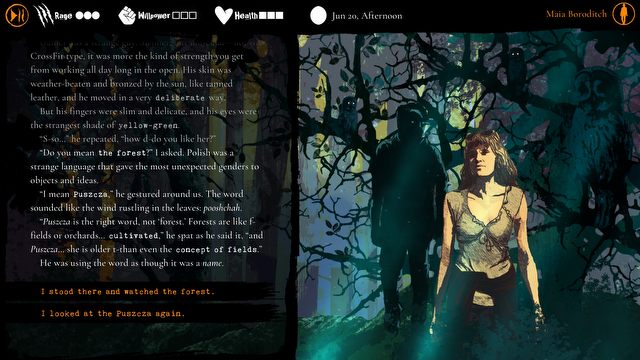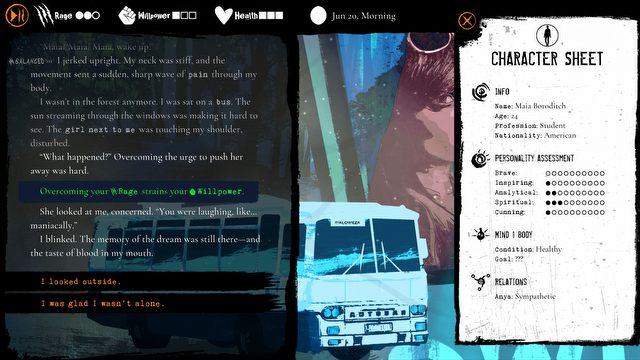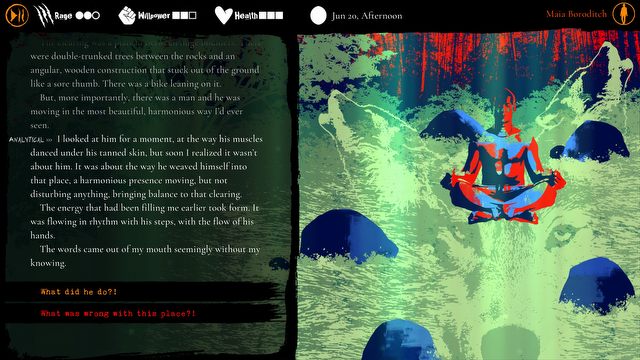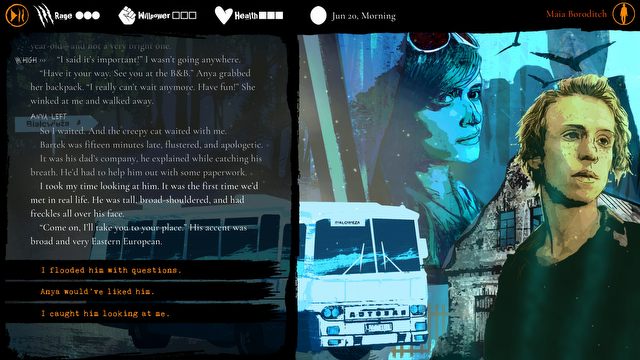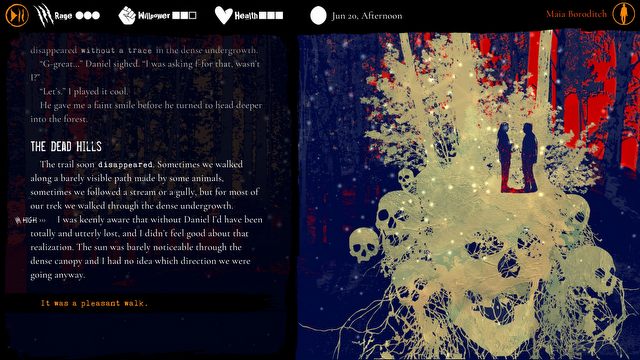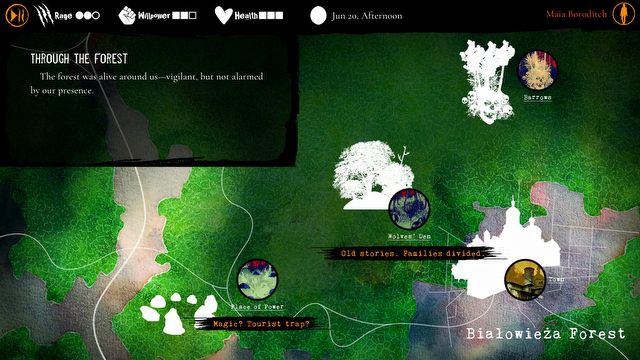In an Ancient Polish Forest – Werewolf: The Apocalypse – Heart of the Forest Preview
In the old-growth Bialowieza Forest, there're werewolves living next to bison and wolves. The Warsaw studio brings the old Werewolf: The Apocalypse system to the Polish country. But is a literary paragraph game enough to interest players around the world?
Different Tales studio is working on a project where I once again had to ask the question: Who the hell is your target audience!? Because when the whole world is salivating at crazy graphics, arguing about the refresh rate, couting fractions of frames per second and getting excited about Ubisoft releasing two hundred episodes of a bland soap operas, a studio from Warsaw is creating a game set in the Werewolf universe, in which playing is... all about reading. And who are they doing it for? It's hard to say. For me. But bear with me, and it may turn out this is also a game for you.
You may remember I sung praises about the studio's previous project. Wanderlust Travel Stories is essentially an original app – well written, with cool ideas for stories, in which you can find your own self. It's a niche game as deep as a niche can be – I don't know how many people played it in the end, but I guess that while most of us like to think of ourselves as smart and intelligent and what not, we often (and to our detriment) prefer Assassin's Creeds over ambitious entertainment. Meanwhile, the proposal from Different Tales is, I think, grounded in some optimistic belief in the recipient, in the player – in us – that we still can and want to reach for things that require focus, imagination, comprehension, empathy and a little intelligence. So if there's one studio that treats the player as an adult, it's Different Tales from Warsaw.
Creators don't lay down their weapons (pens) and after the uber-niche Wanderlust, they experiment bolder: what if we combine a paragraph game with The World of Darkness? What if we embed this system in a primeval Polish forest, one of the most important forests in Europe (namely Bialowieza)? In other words, Different Tales does what others rarely do: they localize a fantasy system in a real location. And they do a fantastic job! So while we're still waiting for Assassin's Creed set in the Carpathia, we'll soon be able to run a werewolf around Poland.
Werewolf: Apocalypse and the World of Darkness
The younger don't know, and the older may have forgotten, but Werewolf: Apocalypse and the World of Darkness universe in general, which included Vampire: Masquerade and Mage: The Ascension used to be quite popular systems around the world. The universe was conceived in 1992 by the well-known fantasy game publisher White Wolf. The game was about werewolves (the so-called Garou), created by goddess Gaia to fight the Wyrm (representing the general decay, destruction and rot, often associated with exploitation, ill-conceived technological progress and consumerism). So Werewolf – while it was about people with too much fur – was a system that dealt with very specific and serious worldview issues. Werewolf came to Poland in 1996. Today, the original manual can be found only in antique shops and online auctions.
The World of Darkness will soon enter its second youth. Another Werewolf was also announced by Cyanide Studio (Styx and Call of Cthulhu), as well as Vampire: The Masquerade – Bloodlines 2 published by Paradox Interactive.
Read to your children to sleep
If you're still uncertain what Werewolf is in the Warsaw edition, I'm not surprised. The game is bold in its concept and communicates only through text, pretty images with stats, and music. That's all.
In order not to elicit a TL;DR response, Werewolf: The Apocalypse – Heart of the Forest displays text sequentially, line by line, corresponding to the pace of our reading. The game forces us to make choices that affect in-game events and statistics every now and then. In the background, we have nice illustrations, which usually underline the given scene. So you're basically reading something like a very interactive story, the outcome of which will depend on your choices. That's what Heart of the Forest is.
The story is about Maya Boroditch, an American of Polish descent, who comes to the old country to study, and decides to visit her hometown, Bialowieza. This is where her mother and the entire strange family lived. We don't know exactly why she ended up in the States, but judging by her dreams and overall mental state, it won't be an easy journey. Werewolf is a universe, in which the so-called Garou (i.e. werewolves) created by Gaia fight the entropy spread by Wyrm, often interpreted as the general modernity and the dangers arising from it. We don't know how much of this will make it into the game, but the character's outline and her connection to the werewolves (of which Maya clearly isn't aware) promises to be an interesting adventure.
WEREWOLF IN THE FOREST

After playing the demo of Werewolf: The Apocalypse – Heart of the Forest, I was so positively surprised that I decided to ask the creators one of the most important questions.
Setting a Werewolf in Poland, in the "last primeval forest" on top of that, seems an absolutely brilliant idea. The forest has become a political topic in recent years for Poles – do you want to speak about forest management and ecology of the area? Because if so, I know who will be the Wyrm.
Artur Gaszyniec: Not all problems happen in mythical, pop-culture America. Every bit of the real world can be reflected in the World of Darkness. It was something that attracted players to the World of Darkness – they could play in real locations. It's fun to explore other places through the lens of mystery or fantasy. Plus, we like to make games that are firmly embedded in reality and touch on real themes: even if they're a camp horror film about werewolves. We decided on Bialowieza because a few years ago, the topic of logging in the forest was really heated. Bialowieza is a very unique ecosystem and unlike forests which are subject to cultivation and regulation, the forest is mostly left to itself. Dead trees lie there, rotting – it's a primal cycle of life and death. Too much interference can ruin it. There's a national park there, so in theory it is strictly protected area, but around it are forests that are part of the ecosystem but do not legally constitute part of the National Park, so they're heavily exploited by ordinary, commercial felling. All the classic themes of Werewolf are right there – primordial nature, greed, big corporations, machines – because we're not talking axes and chainsaws; we're talking harvesters able to cut down a two-hundred-year-old tree and cut it into planks in twenty seconds. The protests became notorious in media and were very complicated because this thing is not 100% clear. Indeed, some kind of forest management is required, because with the current climate change, the Forest left to itself will die, and the ecosystem will change anyway... in addition, this conflict shows other contemporary themes, such as growing authoritarianism of the state, the use of the police for business purposes, various forms of activism, on this side of the law or otherwise, and all this is happening on the border between Poland and Belarus, a place with an incredibly complicated history itself.
Artur Ganszyniec, Different Tales
RPG System
Somewhere between the lines and the nicely written paragraphs, the mechanics, points and dependencies are hidden. The gameplay is defined by the main factors mentioned above: rage, willpower, and health, and many modifiers describing our personality (courage, inspiration, analytical, spirituality, and cunning). Both the narrative and the choices we make will be determined by them. Rage is a basic stat for a werewolf – the more we have it, the more efficient and radical we are, but at the same time we become quite, well, brutal. A low rage factor will allow us to think cooler, but at the same time it will make us less powerful.
The rule of the thumb is: overcoming rage requires willpower. In simple terms, this means that we may sometimes be unable to make a decision, because our character won't have enough psychological strength. Werewolf: Apocalypse in the original is, of course, a venerable RPG, so we'll get all sorts of statistics, attributes and choices to perform our character the way we want. After a while spent with the game, I'm still not sure whether this system has legs. What I do know is that it's working and encouraging further experimentation.
The game begins with a dream in which we determine the factors of our character by making some choices, but subsequent choices made during the course of the story will modify these parameters. That's not all – the game also has a system of friends and foes. The NPCs we encounter will form opinions about us. It is difficult to say what long-term impact this will have, because the demo of shows just the very beginning, but it seems to be an interesting concept.
Wolf in human skin
The choices really do seem to matter – I played the demo twice. The first time I didn't meet Bartek at all, because I couldn't convince my companion to wait for him. During my second approach my character lost it, but it allowed me to learn more about the world. So it seems that the story may really be heading in different directions depending on what we do.
The writing itself is top-notch. I used to do literary criticism, and I can safely say that the prose in Werewolf: Heart of the Forest reads fantastically. Descriptions of nature and surroundings seem to hide some unsolved and disturbing mystery – the characters seem to hide secrets from us, and their personalities and motivations are presented in a captivating way. The dialogue lines are written so that I think each of us will find something for ourselves (even a psychopaths, because we can play a character acting under the influence of aggressive emotions – the game emphasizes that there are no bad choices, just another story). No wonder, because the writing team includes Artur Ganszyniec (author of the script for the first Witcher; he also worked on Witcher 2, Call of Juarez: The Cartel and Wanderlust Travel Stories) as well as Jacek Brzezinski (Witcher 1, Witcher 2 or Dead Island Riptide). So knowing the earlier works of these gentlemen, I am sure that Werewolf: Apocalypse – Heart of the Forest will read better than many fantasy novels.
The main character seems very relatable, and the importance of that in a text-based game can't be stressed enough. The mystery the creators are brewing for us has at least several levels. First, the pedigree of Maya (an American who comes to Poland to learn about her roots in the Polish countryside) is interesting. Second, the presence of the animalistic element in her psyche and all the baggage of the RPG system will probably entangle us in a great, spiritual and bloody journey.
TL;DR
Artur Ganszyniec and Jacek Brzezinski, creators, or restorers, of "Polish Werewolf: Apocalypse," face quite a task. First, they will have to reignite the long-dormant bloodlust of fans of this fictional universe, which – and I say this rather as a layman, claiming the eternal right to ignorance – has been somewhat forgotten. In an era when Warhammer got several big games and many smaller ones, the only people that still remember Werewof are probably those, who still howl to the full moon.
Secondly – although after everything I have read and seen, I am absolutely excited – the niche in which Different Tales boldly creates seems even more closer to extinction than old-growth forests. Don't get me wrong – I cheer, support and even happily chain myself to the trees that Different Tales will plant, but sometimes I get the impression that we are more likely to talk about who we want to be, rather than who we actually are. We theorize that we love Italian cuisine and fresh seafood, but we're going to eat at KFC.
But maybe I'm wrong – I sure hope so. Because Werewolf: The Apocalypse – Heart of the Forest promises to be delicious – bloody, chunky, and, in addition, and incredibly original. After all, how many games let you roma ancient Polish forests?
